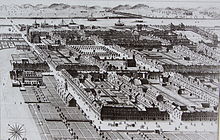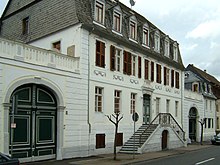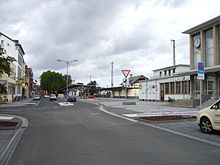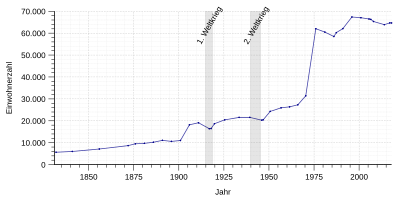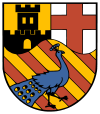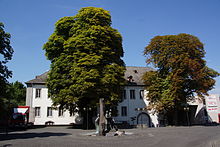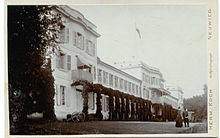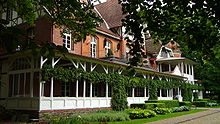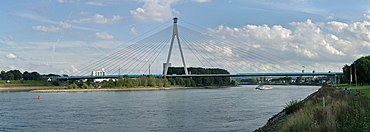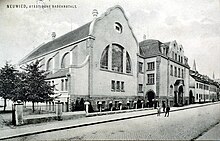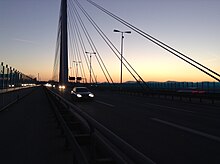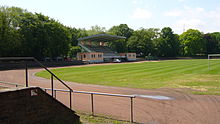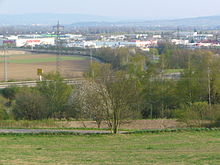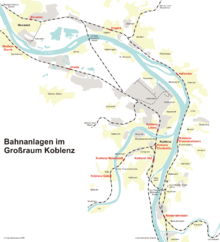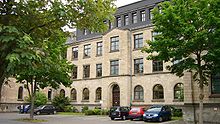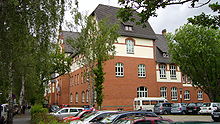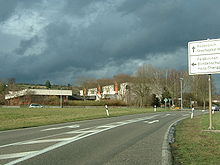Neuwied
| coat of arms | Germany map | |
|---|---|---|

|
Coordinates: 50 ° 26 ' N , 7 ° 28' E |
|
| Basic data | ||
| State : | Rhineland-Palatinate | |
| County : | Neuwied | |
| Height : | 60 m above sea level NHN | |
| Area : | 86.5 km 2 | |
| Residents: | 64,765 (Dec. 31, 2019) | |
| Population density : | 749 inhabitants per km 2 | |
| Postcodes : | 56564, 56566, 56567 | |
| Primaries : | 02631, 02622 | |
| License plate : | NO | |
| Community key : | 07 1 38 045 | |
| City structure: | 13 districts | |
City administration address : |
Engerser Landstrasse 17 56564 Neuwied |
|
| Website : | ||
| Lord Mayor : | Jan Einig ( CDU ) | |
| Location of the city of Neuwied in the Neuwied district | ||

Neuwied is a large city belonging to the district and the seat of the district administration of the Neuwied district in the north of Rhineland-Palatinate . It is located on the southern edge of the district on the right bank of the Rhine , about ten kilometers northwest of Koblenz , at the mouth of the River Wied, which rises in the Westerwald . With around 65,000 inhabitants, Neuwied is the seventh largest city in Rhineland-Palatinate and at the same time the largest city in the state.
Founded in 1653 as a planned town , Neuwied became one of the first sanctuaries for religious refugees in Germany after 1662 and developed into one of the country's earliest industrial cities since the middle of the 18th century . The variety of Christian denominations as well as numerous schools and industrial companies shape the city to this day.
Neuwied is designated as a medium-sized center according to state planning .
Geography and climate
Geographical location
Neuwied is located on the right bank of the Rhine at the foot of the Westerwald near the mouth of the Wied River . In contrast to the otherwise narrow valleys of the Middle Rhine , the mountain slopes in the Neuwied basin recede a few kilometers. The federal city of Bonn is located around 50 kilometers northwest of Neuwied.
Expansion of the urban area
The urban area has an area of 86.5 square kilometers. It covers about the right-hand side of the Rhine half of the basin from about Rhine kilometer 600.3 (about 400 m downstream of the mouth of the Saynbach and almost 200 m before the beginning of the Engers location ) downstream to about 15 m before Rhine kilometer 612.6 (about 150-200 m below) the local situation Fahr ) as well as the first altitude areas of the Niederwesterwald .
The southernmost point of the Neuwied district , and thus also the city of Neuwied, is located in the Rhine at 50 ° 24 '42.59 " N , 7 ° 29" 16.92 " E , near Rhine kilometer 605.1, between the Urmitzer Werth and the Weißenthurmer Werth . The northernmost point of the city Neuwied is situated at 50 ° 30 '31.81 " N , 7 ° 23' 39.98" O in Nonnenbach tal, north of the Wüstung skirt field . The westernmost point in the city Neuwied is situated at 50 ° 30 '2.77 " N , 7 ° 22' 59.88" O in the valley of Rockenfelder stream , west of the field Wüstung skirt. The easternmost point of the city Neuwied is situated at 50 ° 27 '50.36 " N , 7 ° 34' 59.86" O in Saynbach valley, northwest of the local part Stromberg the city Bendorf .
topography
terrain
The inner city area is part of an old tributary of the Rhine and is extremely vulnerable to flooding . In the heaviest flood ( flood in 1784 ), the Rhine flood was over four meters high in the streets. After three severe floods in 1920, 1924 and 1925/1926, planning began for a dike construction that was to shut off the entire old arm of the Rhine. This dike was completed in 1931.
At the point where the Rhine leaves the area of the city of Neuwied, it flows - depending on the water level - at a height of about 53 m above sea level. NN and is thus the deepest point in the area. The height difference of the Rhine from the entrance into the area of the city of Neuwied to the exit is about 4 m.
Surveys
The 368.75 m above sea level. NHN highest elevation in the area of the city of Neuwied is on the Rhein-Wied-ridge of the Niederwesterwald , in the Rockenfeld district , in the Kreutzheck corridor , south of the Rockenfeld desert , near the city limits and near the Upper Germanic-Raetian Limes that runs there , with the small fort "Am Forsthofweg" located on this elevation .
Some other surveys in the area of the city of Neuwied are:
- nameless summit (363.3 m) on the Rhine-Wied ridge of the Niederwesterwald, in the Rockenfeld district , in the Rockenfelder Wald ,
- nameless summit (356.2 m) on the Sayn-Wied plateau of the Niederwesterwald, in the Heimbach district , near the border with the Gladbach district , in the Heimbacher Wald , near the border with the Gladbacher Wald , at the guard post 1/41 of the Upper Germanic-Raetian Limes near the small fort Anhausen ,
- Lückenberg (314.1 m) on the Rhine-Wied ridge of the Niederwesterwald, in the Hüllenberg district , northwest of Feldkirchen ,
- Harmorgenberg (297.0 m) on the Sayn-Wied plateau of the Niederwesterwald, in the Weis district , in the Weiser Wald , northeast of the Weis district, which belongs to the Heimbach-Weis district, above the Saynbach valley,
- Up on the Köppel (234.2 m), on the Sayn-Wied plateau of the Niederwesterwald, in the Oberbieber district , between the Engelsbach and the Aubach , north-northeast of Oberbieber ,
- Köppel (Below on the Köppel) (182.3 m) on the Wollendorf-Gladbach basin slope of the Middle Rhine basin , in the Oberbieber district , between the Engelsbach and the Aubach, near the reservoir in the Aubachtal, northeast of Oberbieber ,
- Wingertsberg (181.1 m) on the Wollendorf-Gladbach basin slope of the Middle Rhine basin, in the Oberbieber district , on the northeastern edge of Oberbieber , above the Aubach valley,
- Kreuzberg (177.0 m) on the Wollendorf-Gladbach basin slope of the Middle Rhine Basin, in the Altwied district , north-northeast of the Kümmelberg settlement and south of Melsbach .
climate
The annual precipitation is 664 mm. The precipitation is in the lower third of the values recorded in Germany. Lower values are registered at 33% of the measuring stations of the German Weather Service . The driest month is February. Most of the precipitation falls in July, 1.7 times more precipitation than in February. The precipitation hardly varies and is very evenly distributed over the year. Lower seasonal fluctuations are recorded at only 8% of the measuring stations.
City structure
The city of Neuwied consists of the city center and twelve districts, each represented by a local advisory board and a local councilor.
Heddesdorf has been part of the city center since 1970 and has no local advisory board or mayor, but is still listed statistically as a district, for example when evaluating population development.
Neighboring communities
The following cities and municipalities border the city of Neuwied:
- clockwise on the right bank of the Rhine, starting on the Rhine in the northwest, the municipalities of Leutesdorf , Hammerstein , Rheinbrohl , Datzeroth , Ehlscheid , Melsbach , Rengsdorf , Anhausen , Meinborn and Isenburg as well as the town of Bendorf , which belongs to the district of Mayen-Koblenz ;
- on the left bank of the Rhine the opposite local communities Kaltenengers and Urmitz as well as the cities Mülheim-Kärlich , Weißenthurm and Andernach , all of which belong to the district of Mayen-Koblenz.
history
As a baroque start-up, Neuwied is relatively young compared to other Rhenish towns, but it is steeped in history.
Prehistory and Roman times
The oldest evidence of human settlement in the area of today's town of Neuwied comes from the Gönnersdorf site , which was discovered during excavations in the Feldkirchen district (in the district of Gönnersdorf) and dates back to the 16th millennium BC. . AD was dated. Today the finds from these excavations are exhibited in the archaeological research center and museum for human behavioral evolution Monrepos , which is located in the villa "Waldheim" in Monrepos - which is part of the Segendorf district - which has since been expanded for this purpose .
The area has been permanently settled since the Celtic and Roman times at the latest . Archaeological finds indicate that Julius Caesar made his first Rhine crossing , which he mentions in De Bello Gallico , around 55 BC. Chr. Using a Pioneer Bridge pointed out, the right of the Rhine bridgehead was on the Neuwied area. From the 1st to the 3rd century there were Roman forts in Heddesdorf and Niederbieber , which served to secure the Roman-Germanic Limes , which, following the heights of the Rhine, ran through today's urban area. After the border was moved back to the Rhine in 260 , there was a Burgus in the Engers district , which served as a base for the Roman Rhine fleet .
Urban area in the Middle Ages
After the withdrawal of the Roman legions, the urban area became part of the Frankish sphere of influence from the 5th century . Some districts of Neuwied were mentioned in documents as early as 773. The documents from the 8th century assign the city area to the Engersgau . The Gaugrafen called themselves from 1129 Count von Wied . The Engersgau later disintegrated. After the first Earl's House of Wied died out in 1244 and the subsequent fragmentation of the rule , Count Wilhelm von Isenburg-Braunsberg (later Wied) brought what would later become the city under his control. Engers received town charter in 1357, but fell to Kurtrier after armed conflicts . The residence of the County of Wied was Altwied Castle .
City foundation
The county was largely impoverished during the Thirty Years' War . Count Friedrich III promised himself from participating in the Rhine trade . zu Wied economic impetus. Therefore, in 1646, he had a small fortification built on the narrow Rhine front of his county, which was actually unfavorably located because of frequent floods, at the site of the destroyed hamlet of Langendorf. For the Newen Wiedt house and for the small settlement that surrounded it, he obtained city rights from Emperor Ferdinand III in 1653 . This year is considered the founding date of the city of Neuwied. The count moved his residence here. The grid-shaped planned town was destroyed by French troops in 1694 during the Palatinate War of Succession . In 1706 the construction of today's three-wing palace complex began.
Tolerance, Enlightenment and Industrialization
In order to attract more residents to the slowly growing city, the Count granted it a town charter privilege in 1662, which guaranteed the residents of Neuwied numerous freedoms, including the right to elect a magistrate , lower jurisdiction , tax collection , freedom from labor and - exceptional for that time - the right to extensive religious freedom . In the religious sanctuary of Neuwied, the imperial law principle " cuius regio, eius religio ", according to which the sovereign alone determined the religious confession of his subjects, was largely overridden. This induced religious refugees of different denominations to settle in the city, which consequently grew rapidly. In the 17th and 18th centuries, Neuwied's status as a city of exiles made it a specialty among German cities.
Frederick III's son, Count Friedrich Wilhelm zu Wied-Neuwied , also essentially retained the policy of religious tolerance . Due to the high cost of building the new residential palace, at the beginning of the 18th century there were disputes between the count and the Neuwied magistrate about the city's income, which should be divided between them after the privilege of 1662. The magistrate then initiated a subject trial against the count before the Reich Chamber Court, which ended in a compromise acceptable to both sides in 1721: In the so-called "Wetzlar Punctation" not only the financial issues were settled, but the Wiedische tolerance policy was also recognized under Reich law. Religious tolerance and documented freedoms attracted more and more immigrants to the young city. Under Friedrich Wilhelm's son Johann Friedrich Alexander - raised to the rank of imperial prince in 1784 and a representative of enlightened absolutism - members of seven different religious communities lived in Neuwied in the 18th century: Calvinists - to which the count's house belonged -, Lutherans , Catholics , Mennonites , inspired people , Moravians and Jews .
The immigrants persecuted in other places often brought new branches of industry and skills with them, which brought Neuwied to an economic boom and helped to a comparatively early industrialization . The furniture from the manufactory of the Herrnhuter Abraham and David Roentgen or the artistic clocks by Peter Kinzing were in demand at the royal courts all over Europe . The Rasselstein ironworks, which was founded by Count Johann Friedrich Alexander in 1738 and still exists today - owned by the entrepreneur Carl Wilhelm Remy since 1784 - developed into one of the leading German steel and rolling mills . Among other things, the rails for the first German railway line Nuremberg - Fürth were manufactured there.
Thanks to its tolerant atmosphere, Neuwied also became a center of Enlightenment on the Middle Rhine in the 18th century . One example of this was the founding of the Neuwied Freemason Lodge Karoline to the Three Peacocks , which u. a. Ludwig van Beethoven's most important teacher in Bonn, who belonged to music director Christian Gottlob Neefe . The Württemberg Pietist and theosophist Friedrich Christoph Oetinger (1702–1782) published in this " sanctuary " his work Die Eulerische und Frickerische Philosophie Ueber Die Music, als a reason for the New Philosophical System , which u. a. came to the library of the Freemason Wolfgang Amadeus Mozart in Vienna.
The end of the city as a Viennese residence came with the French Revolutionary Wars : In the Battle of Neuwied , which is noted on the Arc de Triomphe in Paris , French revolutionary troops under General Lazare Hoche won the first major victory in the coalition wars against the Austrian army in 1797 .
19th and 20th centuries
In the course of secularization and mediatization after the Reichsdeputationshauptschluss of 1803, the Electoral Trier part of today's city area and in 1806 the Wied area and its residence city fell to the Duchy of Nassau . In 1815 the entire urban area of Prussia was added. Neuwied became the administrative seat of the Prussian district of the same name within the Rhine Province ; however, the counts still exercised rights as class lords until 1848 . In the 19th century, Neuwied was not only an industrial location, but also a school town with prestigious educational institutions of supraregional importance.
Development of industry and transport
Neuwied is one of the earliest industrial locations in Germany. The Rasselstein iron rolling mill , founded in the 18th century, still exists today. In the middle of the 19th century, the English entrepreneur John Player founded the Albion iron and steel mill , which produced black plate. After the bankruptcy in 1856, the plant was taken over by Buderus in 1857 and operated as the Germania black and tin plate plant until it was closed in 1883 . In 1918, the Gockel-Werke settled on the site, built railway wagons there and maintained them for the entire Reichsbahn area.
In the immediate vicinity, on the southern outskirts, directly on the Rhine, stood the Hermannshütte ironworks , founded in 1855 by the mining company Louis Vogts & Co. from Weilburg. In 1871 Alfred Krupp, Essen, took over the factory and used it as a production site until 1925. Since 1928 the Wikingwerke, which were later taken over by Dyckerhoff -Zement, were built in the same place . In 1911 the Hobraeck veneer factory also settled in this industrial area.
Another large company was the Mauser-Werke, which initially produced tin barrels, later also tin bathtubs and tubular steel office furniture. The machine factory Winkler & Dünnebier , which manufactures special machines for paper processing, previously also machines for confectionery production (today Winkler und Dünnebier Süßwarenmaschinen GmbH in Rengsdorf ) has existed since 1913 . Both companies are among the world market leaders in their fields. The first customer of Winkler & Dünnebier was the Neuwied envelope factory Willy Strüder, founded in 1889 . Its founder was the son of Wilhelm Strüder, who founded the Strüder publishing house in Neuwied in 1843 .
Due to the abundant occurrence of pumice in the Neuwied basin, the pumice industry for the production of masonry stones developed in Neuwied from the middle of the 19th century. As early as 1892/93, 132 million stones were manufactured, which were delivered to Bavaria, Württemberg, Schleswig-Holstein and Switzerland . As a result of the progressive machine production, 333 million stones were already produced 20 years later. In 1931 there were around 800 companies with 6,000 employees in the Neuwied Basin. In 1952, 3.95 million tons of pumice building materials were produced and 1 million tons of pumice were exported. This amount was enough to build 250,000–270,000 apartments. Meanwhile the pumice deposits are almost exhausted, so that this branch of industry has lost its importance.
Neuwied has been connected to the railway line on the right bank of the Rhine since 1870, and in 1918 the Urmitz railway bridge between Engers, which now belongs to Neuwied, and Urmitz on the left bank of the Rhine was completed.
In 1901 the Neuwied Kreisbahnen established the first tram connection to Oberbieber . In 1909 routes via Engers to Gladbach and from Neuwied train station to the banks of the Rhine also went into operation. The tram connections were replaced by trolleybuses in 1949 and 1950 , which were in use until the early 1960s.
In 1904, the city expanded again considerably through the incorporation of neighboring Heddesdorf. Its former mayor Friedrich Wilhelm Raiffeisen was one of the founders of the German cooperative system . In order to protect Neuwied from the almost annual flood disasters, a 7.5-kilometer-long protective dike was built on the initiative of Mayor Robert Krups from 1928 to 1931 , the construction of which also served as a job creation measure during the global economic crisis . In 1935 the first bridge was built, connecting Neuwied with the left bank of the Rhine near Weißenthurm . During the National Socialist era , numerous members of the Jewish community were deported and murdered, and supporters of the traditionally strong free churches in Neuwied were persecuted. In World War II the city was destroyed about 18 percent of bombs.
On December 22nd, 1947, the Neuwied railway accident occurred , one of the worst train accidents in German post-war history: When two express trains collided near Neuwied-Irlich, 41 people died and numerous were injured. The French occupation troops and the Lohmann bandage company proved to be helpers in an emergency . This is located directly at the scene of the accident.
In the post-war period Neuwied regained its importance as a medium-sized industrial location. Today the city has extensive commercial areas with good transport connections, including a Rhine port.
In 1972 the planned construction of a nuclear power plant in the greater Koblenz area became known. A possible location near Neuwied was discarded due to flood protection. Instead, the Mülheim-Kärlich nuclear power plant was built on the left bank of the Rhine.
Urban development
Incorporations
Heddesdorf , which is now part of the inner city , was incorporated into Neuwied on April 1, 1904.
In the course of the Rhineland-Palatinate territorial and administrative reform that began in the mid-1960s , the “Eighth State Law on Administrative Simplification in the State of Rhineland-Palatinate” of July 28, 1970, which came into force on November 7, 1970, changed the towns of Neuwied ( 31,232 inhabitants) and Engers (5,348) as well as the communities Altwied (673), Feldkirchen / Rhein (5,380), Gladbach (2,492), Heimbach-Weis (7,280), Niederbieber-Segendorf (7,464) and Oberbieber (3,819) were dissolved and incorporated into the new town of Neuwied incorporated.
The former communities were restructured several times in the previous decade, including many were largely independent up to this point or became districts of other communities:
- Altwied was an independent local community in the Niederbieber-Segendorf community until 1970
- Block was a district of Heimbach-Weis until 1970
- Engers was an independent town until 1970 and the seat of the Engers community
- Fahr , previously an independent municipality, became a district of Feldkirchen in 1966
- Feldkirchen was formed on August 1, 1966 from the communities of Fahr, Gönnersdorf, Hüllenberg, Rockenfeld and Wollendorf; On November 28, 1967 the community was given the addition of "Rhine" to its name
- Gladbach was an independent municipality in the Engers association until 1970
- Gönnersdorf , previously an independent municipality, became a district of Feldkirchen in 1966
- Heimbach-Weis was an independent municipality in the Verbandsgemeinde Engers until 1970 and was formed from the communities Heimbach and Weis on September 1, 1960
- Hüllenberg became a district of Feldkirchen in 1966
- Irlich was an independent local congregation in the Niederbieber-Segendorf community and was incorporated on June 7, 1969
- Until 1970 Niederbieber was a district of Niederbieber-Segendorf in the association of the same name
- Until 1970, Oberbieber was an independent community in the Niederbieber-Segendorf community
- Rockenfeld became a district of Feldkirchen, but was already in dissolution at the time and is now a desert
- Rodenbach was incorporated into Niederbieber-Segendorf on June 7, 1969
- Torney was a district in the municipality of Niederbieber-Segendorf until 1970
- Segendorf was a district of Niederbieber-Segendorf until 1970
- Wollendorf became a district of Feldkirchen
On December 31, 1995 the “ official population ” for Neuwied was 67,374 according to the Rhineland-Palatinate State Statistical Office (only main residences and after comparison with the other state offices); this number is a historic high to this day.
Population development
Around 1700 Neuwied only had around 1,500 inhabitants. The population grew only slowly and continued to decline due to the numerous wars, epidemics and famine. Only with the beginning of industrialization in the 19th century did population growth accelerate. While only 5,600 people lived in the city in 1831, in 1905, including Heddesdorf, which was incorporated a year earlier, there were already 18,000.
By May 27, 1970, the population rose to 31,400 and then doubled to 63,000 on November 7, 1970 after the formation of the "New Town Neuwied" including the surrounding areas.
The following overview shows the number of inhabitants according to the respective territorial status. These are census results (1) or official updates from the State Statistical Office. From 1871, the information relates to the “local population”, from 1925 to the resident population and since 1987 to the “population at the place of the main residence”. Before 1871, the number of inhabitants was not determined using a uniform survey method.
|
|
politics
Since 1946, the city and the district of Neuwied have belonged to the then newly formed state of Rhineland-Palatinate .
City council
The city council in Neuwied consists of 48 honorary council members and the mayor as chairman.
| SPD | CDU | Green | FDP | left | AfD | FWG | CSFL | I do | total | |
|---|---|---|---|---|---|---|---|---|---|---|
| 2019 | 12 | 15th | 7th | 2 | 2 | 5 | 3 | - | 2 | 48 seats |
| 2014 | 17th | 18th | 4th | 1 | 2 | 3 | 2 | 0 | 1 | 48 seats |
| 2009 | 18th | 16 | 3 | 4th | 2 | - | 4th | 1 | - | 48 seats |
| 2004 | 17th | 22nd | 3 | 2 | - | - | 4th | - | - | 48 seats |
- FWG = Free Voters' Group Neuwied eV
- CSFL = Christian Social Free List
The twelve districts are represented by local councils and local councilors.
mayor
Jan Einig (CDU) has been the Lord Mayor of Neuwied since November 2017 . He was elected on October 15, 2017 in a runoff election with 59.56% and succeeded Nikolaus Roth, who died in the summer of the same year. The first full-time alderman is Mayor Michael Mang (SPD), who had previously lost the runoff election to Einig. The second full-time alderman has been Ralf Seemann ( Bündnis 90 / Die Grünen ) since November 2019 .
| Surname | Term of office |
|---|---|
| Ludwig Schön (SPD) | 1964-1977 |
| Karl-Heinz Schmelzer (SPD) | 1977-1989 |
| Manfred Scherrer (SPD) | 1990-2000 |
| Nikolaus Roth (SPD) | 2000-2017 |
| Jan Einig (CDU) | since 2017 |
Member of the state parliament
- Neuwied constituency : Sven Lefkowitz (SPD), moved up for Fredi Winter
- Country list : Jan Bollinger (AfD)
Member of the Bundestag
- Neuwied constituency : Erwin Josef Rüddel (CDU)
- Country list : Andreas Bleck (AfD), Sandra Weeser (FDP)
Town twinning
-
 Bromley (England) , UK , since 1987
Bromley (England) , UK , since 1987 -
 Drom Hasharon , Israel , since 1987
Drom Hasharon , Israel , since 1987 -
 Güstrow ( Mecklenburg-Western Pomerania ), since 1989
Güstrow ( Mecklenburg-Western Pomerania ), since 1989 -
 Beverwijk , Netherlands , 1965–1990 (today friendly relations)
Beverwijk , Netherlands , 1965–1990 (today friendly relations) -
 Kinyamakara , Rwanda (loose partnership)
Kinyamakara , Rwanda (loose partnership) -
 Suqian , People's Republic of China , since 2015
Suqian , People's Republic of China , since 2015
coat of arms
|
Blazon : “Under the humiliated wave shield head split by gold and silver - in the front a continuous, five-pinned black wall with an open gate, surmounted by a three-pinned black tower with two open windows, behind a continuous red cross - in gold four red diagonal bars, covered with a blue peacock with a closed tail walking to the left. "
The coat of arms has been legally valid since January 2nd, 1974. |
|
| Reasons for the coat of arms: The tripartite division of the coat of arms refers to the threefold composition of the new town of Neuwied from the former town of Neuwied and the two municipalities of Engers and Niederbieber-Segendorf since November 7, 1970. The undulating border of the head of the shield symbolizes the city's location on the Rhine their Rhine bank border. The peacock with the four sloping beams (with a five-pinned wall crown on the edge of the shield) formed the coat of arms of the old town of Neuwied from the 2nd half of the 19th century to 1970, identical in heraldic image and figure to the family coat of arms of the Counts of Wied . The wall tower as a symbol for the local Roman fort and at the same time for Altwied Castle, ancestral castle of the Wied counts, is taken from the coat of arms of the former community of Niederbieber-Segendorf. The red cross taken from the coat of arms of the former municipality of Engers refers to the Electorate's past of the area. |
Culture and sights
Theater, music, festivals
The palace theater building was erected in 1799 and converted into a private and residential theater in 1840. It was renovated in 1977 and has since been the seat of the Rhineland-Palatinate state theater . The theater with space for 300 visitors is located in an adjoining building of the Neuwied Castle and offers a comprehensive program of classics and modern plays, revues and youth theater.
In the former Premonstratensian Abbey of Rommersdorf , the cultural office of the city of Neuwied organizes the “cloister concerts” (classic) in May and the Rommersdorf Festival with children's theater in summer.
The Landesmusikakademie Rheinland-Pfalz is located in the Engers district in the so-called “Meisterhaus” and offers courses and seminars as a musical training facility. The state foundation Villa Musica is housed in Engers Castle, which also organizes open-air events with classical music and an annual baroque festival.
Another cultural bearer is the choir of the Marktkirche . There are also concerts and other events for teenagers and young people; a good part of it is organized by the local youth council and the child and youth office.
The “Minski” (Wednesday to the cinema), which emerged from the “Doki” (Thursday cinema), has received many awards and is unique in Germany. Here, “high quality” films are shown in the Schauburg cinema beyond the mainstream, at reduced prices.
All kinds of events take place in the “Stadthalle Heimathaus”, such as the Neuwied Jazz Festival in November or the carnival sessions of the Funken-Rot-Weiß 1884 Neuwied e. V. or the honor guard. Well-known artists also perform in the Heimathaus.
Furthermore, Neuwied has had a citizens' television network, the Open Channel Neuwied, since 1994 . With Andernach he shares the broadcasting slot on cable TV, special channel 03. The transmitter, which Adenau and Koblenz have also joined, has been called OK4 since summer 2012 and can also be received on digital cable TV.
The German punk band Toxoplasma comes from Neuwied .
Museums and memorials
In the Roentgen Museum , the focus of local history is on the works of Abraham and David Roentgen and the work of Friedrich Wilhelm Raiffeisen . The former district museum was now called Museum Rhein-Wied and was renamed the Roentgen Museum in June 2007 .
The Monrepos - Archaeological Research Center and Museum for Human Behavioral Evolution is a branch of the Roman-Germanic Central Museum and offers information about early history. Various activities for families and children are carried out in summer.
The dike information center Neuwied (dyke museum) explains the flood protection system of the city of Neuwied and shows many photos and documents from the time before the dyke was built.
The Mennonite Church Gallery offers changing exhibitions with regional and national artists.
The German Flipper Museum shows over 60 pinball machines from the time since the 1930s.

Memorial sites for the victims of National Socialism
On November 23, 1960, a memorial plaque was unveiled on the former Jewish schoolhouse. The school building was demolished in 1980. The memorial plaque from 1960 was attached to a side wall of the new building erected on the same spot and unveiled again on June 30, 1983.
The Neuwied Synagogue , built in 1748, was badly damaged by the “ November pogroms 1938 ” and torn down shortly afterwards. Engerser Strasse between Schlossstrasse and Theaterplatz was renamed “Synagogengasse” by a resolution of the city council on June 30, 1983.
At the request of the German-Israeli Circle of Friends in Neuwied, all Jewish cemeteries in the Neuwied district have been listed as historical monuments since May 1989 . Symbolic graves for those Jewish citizens of Neuwied who perished in concentration camps are laid out on the Jewish cemetery in the Niederbieber district of Neuwied, which is probably over 400 years old .
In 2003, bronze “ stumbling blocks ” by Cologne artist Gunter Demnig were set into the pavement in front of houses in the city center where victims of National Socialism (mainly Jews, Sinti and Roma) lived.
Palaces and castles
- Altwied Castle : Today's ruins, originally called "Burg Wied", were the ancestral seat of the Counts of Wied. The castle was founded in 1129 and abandoned in the 17th century after Neuwied was founded.
- Braunsberg Castle : It was built around 1200. On the site of the ruin there is a district forester of the Princely-Wiedische forest administration.
- Engers Castle : The late Baroque hunting and pleasure palace from the 18th century, located in the Engers district directly on the Rhine, is home to the office of the Landesmusik Foundation ( Villa Musica ).
- Neuwied Castle : The residential castle of the Princes of Wied, located in the northern part of the city center, was built in its present form in the 18th century. Until 1804 it was the seat of government of the Principality of Wied.
Former castles
- Friedrichstein Castle : In the 17th century, construction of an unfortified castle began on the rocky bank of the Rhine at the foot of the Hohen Ley above the Fahr district, which was probably not completed. When the railway on the right bank of the Rhine was being built, the ruins were demolished in 1868. A memorial stone placed next to Bundesstraße 42, part of the window cornice of the castle, commemorates the castle, which was also known as the "Devil's Castle".
- Monrepos Castle : It was built in the 18th century as the summer residence of the counts and later princes of Wied. It was popularly known as the “White Castle”. The later dilapidated building was burned down in 1969 because repairs seemed too expensive. Today the so-called Waldheim , also known as the Princesses House of Monrepos, houses the Monrepos - Archaeological Research Center and Museum for Human Behavioral Evolution .
- Former hunting lodge Nodhausen of the royal family in Segendorf, in which the Parkrestaurant Nodhausen is located today.
Limes and Roman fort
The Upper German Limes , which began in the nearby Rheinbrohl , led a few kilometers through today's urban area. In the districts of Rodenbach, Niederbieber-Segendorf, Altwied, Oberbieber, Gladbach, Heimbach-Weis there were two forts, a small fort and over 30 watchtowers and Burgi .
- Heddesdorf Fort : The 2.8 hectare stone fort has an almost rectangular floor plan of around 160 m × 180 m and was surrounded by an 8 m wide moat. The fort was located in today's Heddesdorf district and has been largely destroyed by the overbuilding of residential houses, gardens or streets.
- Niederbieber Castle : The stone fort of 5.2 hectares has a rectangular floor plan of around 265 m × 198 m and was surrounded by a 6 m wide pointed ditch. The fort was located northeast of today's center of Niederbieber and is overbuilt by houses and gardens. Visible remains are the foundation walls of the fort bath and the northern access gate.
- Small fort Anhausen : The former small fort Anhausen was a stone fort with an area of 0.17 hectares and was located in what is now the Neuwied district of Heimbach-Weis. An exact dating has not yet been possible.
See also :
Monasteries, churches and chapels
- Evangelical Church Oberbieber : The church was built on the old foundations of the Nikolauskapelle from the 11th century. The Romanesque, two-storey apse of this chapel has been preserved as a choir, which is considered to be the oldest ecclesiastical monument in the Neuwied district.
- Evangelical Church Niederbieber : Romanesque choir and flank tower from the 13th century with a nave from the 15th century. Under the altar the burial place of Cologne Archbishop Hermann V von Wied .
- Evangelical Market Church from 1884: The church was built by August Hartel from Krefeld. The new building came about because the church of the Lutheran congregation (built in 1789) burned down and the old church of the Reformed congregation (built in 1687) was dilapidated and was therefore torn down. In 2017 she was voted Church of the Year.
- Evangelical church in Heddesdorf with the oldest bell from the 14th century ringing.
- Evangelical St. John's Church in Heddesdorfer Sonnenstraße, which was de-dedicated in October 2013 and converted into a day-care center.
- Evangelical parish church in Engers from 1900: The church, built in neo-late Gothic forms, is dominated by a tower with a pointed pyramid roof. It has been a listed building since 2003.
- The Feldkirche (Neuwied) from the 12th century: It is located in today's Feldkirchen district and was probably built on a prehistoric place of worship.
- Catholic parish church St. Margaretha in Heimbach-Weis from 1772: The church was built by the Trier builder Johannes Seiz . The church tower from the Middle Ages with walls up to two meters thick has a screwed helmet.
- Catholic parish church Maria Himmelfahrt in Gladbach from 1904: built in the post-Gothic style, with an onion dome, which is unusual for the Rhineland. The side altar with a Madonna figure is worth seeing.
- Catholic parish church St. Martin in Engers from 1896: It was built in neo-late Romanesque forms on the site of a previous church. Rhenish-style architectural structures made of brick and tuff.
- Catholic parish church St. Matthias from 1901: Built by Heinrich Krings from Cologne. The neo-Gothic painting was recreated in 1979, the original furnishings are only partially preserved.
- Catholic Church of the Holy Cross , built in 1960–63 based on plans by Alfons Leitl , remarkable for its tower.
- Catholic Church of Our Lady in Heddesdorf from 1958.
- Catholic parish church of St. Peter and Paul in Irlich from 1835: The church in the form of late classicism replaces St. George's church, which dates from the Middle Ages and was demolished at the end of the 19th century.
- Catholic parish church St. Michael in Feldkirchen from 1967.
- Church hall of the Evangelical Brethren : Late Baroque hall church from 1785 in the Moravian quarter. Two galleries, an unadorned white interior.
- Catholic parish church St. Bonifatius in Niederbieber from 1964
- Mennonite Church from 1768: The Mennonites settled in Neuwied before 1680. After a fire in 1985, the building was rebuilt and has been a municipal gallery with changing art exhibitions ever since.
- Former Premonstratensian Abbey of Rommersdorf from the 12th century: The oldest settlement of this order in the area of the old Archdiocese of Trier . The abbey was founded in 1117 and was initially a Benedictine monastery.
- Wülfersberg chapel in Gladbach from the 12th century: A former monastery chapel of the Wülfersberg monastery, near the Rommersdorf abbey.
Flood protection dike
The most striking building is probably the Neuwied Dike, which the locals call the dyke wall . With a total length of 7.5 km, it stretches from the mouth of the Wied to the Engers-Urmitz railway bridge . In the area of the city center is the stone-clad 500 m long dike wall, at the northern end of which is one of the three pumping stations that serve to lower the groundwater. A small dike museum has also been set up there. In the middle of the dyke wall is the “Deichkrone” restaurant and Neuwied's landmark, the water level tower, rises at the southern end. The dike is designed to protect the city from flooding up to 9 m above normal water level. In order to reach the area in front of the dike, where ships used to be loaded and unloaded, three flood gates are installed. After the Second World War, American troops blew up the top of the dike and built a wooden makeshift bridge over the Rhine. This collapsed on February 24, 1947 as a result of heavy ice drift. The dyke hiking trail leads over the dyke wall or in front of it.
On the side of the Rhine, a verse by Goethe is embedded in the masonry at the top of the dike : Keep up against all forces, never bow down, show yourself vigorously, summon the arms of the gods!
Other structures
- Old brewery from 1694: One of the oldest houses in Neuwied, once a brewery that was licensed in 1835.
- Old town hall and bakery in Niederbieber from 1736: The town council met on the half-timbered upper floor with the bell tower, and the town baked its bread in the stone substructure until 1908.
- Old town hall in Engers from 1642 and castle tavern from 1621: group of houses in front of the castle courtyard
- Old town hall in Neuwied from 1740: Formerly a manor house, social facility for the poor and orphans
- Old customs office from 1696: Originally, the salt imported by ship by the Count zu Wied was cleared, stored and sold with a tax surcharge here. The building was a customs office until 1969.
- Engers train station from 1869
- Former casino from 1825
- Gray tower in Engers from the 14th century: part of the city fortifications
- Former royal Prussian teacher training college , today Werner-Heisenberg-Gymnasium
- Raiffeisen Bridge over the Rhine to Weißenthurm on the left bank of the Rhine from 1978: The cable-stayed bridge is one of the city's landmarks, and up to 35,000 vehicles pass through it every day
- Former Roentgenhaus from 1776: Abraham Roentgen's place of residence and work
- Former indoor swimming pool in Marktstrasse, built 1906–1908 in Art Nouveau style, today a listed building
- Herrnhuterviertel and prayer room of the Brethren from 1784/1785
Marina
The Motor-Yacht-Club Neuwied has a large marina with 30,000 m² of water. It is located in the former pioneer harbor and has flood-free berths for 180 boats up to 20 m in length. There are also winter berths for 250 boats on land, some in halls.
The port has a slipway up to 160 tons, a boat filling station, a boat and engine service company, a boat yard and the club's own catering facilities. In 1998 the club was awarded the “Blue Europe” for exemplary environmental protection for the first time.
zoo
The Neuwied Zoo is located in the Heimbach-Weis district and has around 1,200 animals from 155 species on a total area of around 13.5 hectares.
Nature and parks
Neuwied has a total of 20 public parks and green areas. The Rhine-Westerwald Nature Park begins in the north of the urban area . In addition to the Rheinsteig and Rheinhöhenweg long-distance hiking trails , around 220 kilometers of cycling and hiking trails offer a variety of attractive hiking opportunities.
Castle Park
In 1715, a symmetrical baroque garden was laid out as an extension of the castle axis and parallel to the Rhine . Aviaries, fountains, grottos and a pheasantry completed the complex. At the end of the 17th century, the park was redesigned in the style of an English landscape garden. Many exotic plants were also planted, which may have come from Prince Maximilian zu Wied's trips to America.
Today the park has lost much of its quality as a recreational area due to the loss of trees and insufficient maintenance. Except for 6 hectares, which the royal family uses themselves, the park is leased to the city. In 2003, work began on transforming the park into a recreational, play and leisure area, taking into account its historical significance. Many botanical rarities can be admired in the park.
Other important facilities are the English Garden and the herb garden of Rommersdorf Abbey , which are open to the public at all times.
Sports
Among the many sports that can be practiced in Neuwied, include American football , badminton , basketball , billiards , boxing , hockey , fencing , football , golf , canoeing , athletics , mini golf , equestrian , cycling , rowing , shooting , swimming , Tennis , volleyball . Sports for the disabled and senior sports also play an important role . Neuwied has almost 100 sports clubs and corresponding sports facilities in all parts of the city.
The municipal stadium with 8,000 standing and 500 seats was named after the former first DFB President Ferdinand Hueppe , who was born in Neuwied, and is now called the Raiffeisen Stadium . A DFB Cup match between SV Rossbach / Wied and Borussia Mönchengladbach was played here in 2006 . Of the more than 10 football clubs in the city, the Rhineland League club FV Engers 07 is best known and with VfL Neuwied e. V (District League) and the TuS Rodenbach e. V (Regionalliga) there are two women's soccer teams in the city.
Football plays a special role in Neuwied. One of the first football games in Germany is said to have taken place here. From 1865 it was reported that English boarding school students at what was then the Herrnhuter Knabenanstalt brought the game with them to the Rhine.
As everywhere in Germany, women's football is experiencing an enormous upswing in Neuwied. In addition to the regional league team of TuS Rodenbach e. V. women's and girls' football is played in clubs as well as in many schools.
In 2006, the Neuwied women's team was the only regional league team to qualify for the Daun finals. They were only marginally defeated in the semifinals against the then second division team SC 07 Bad Neuenahr II with 1: 3. In Neuwied, three preliminary rounds of the Rhineland Indoor Championships have already taken place. These indoor championships and the Rhineland Cup are the two most important tournaments in women's football at FV Rheinland. On February 29, 2012 Neuwied was the host of the final of the Rhineland Indoor Championships for women.
The women's volleyball team of VC Neuwied 77 has played in the 2nd Bundesliga South since 2015 .
Neuwied is one of the few cities in Rhineland-Palatinate that has a privately owned ice rink. Ice hockey has been practiced in Neuwied since 1980 . Above all, the old EHC Neuwied (1980 to 2000), who was represented in the second highest German ice hockey league from 1994 to the 1999/2000 season and won the championship there in 1997 and 1998 and the DEB league cup in 1997, made the city known nationwide at this time. For this reason, ice hockey in Neuwied has long been considered the city's “biggest advertising medium”. After the EHC had applied for bankruptcy during the 1999/2000 season , the successor club SC Mittelrhein (renamed SC Mittelrhein-Neuwied from 2001 ) was founded two weeks after the opening of insolvency proceedings . He first played one season in the regional league and from 2001 until the end of the game operations due to problems with the home ground ("Icehouse Neuwied") after the 2005/06 season in the third-class league . The city of Neuwied thus lost one of its most successful sports. The sport of ice hockey was continued in the 2006/2007 season by VFE Neuwied, which was followed by a successor club under the old name EHC Neuwied from the 2007/2008 season. Since the 2012 season, EHC Neuwied has been playing with the first team in the Oberliga and with the second team in the Rhineland-Palatinate Regional League (see also: Ice Hockey in Neuwied ).
The oldest sports club is the Neuwieder Schützengesellschaft from 1833 . The largest association is the TV Feldkirchen with around 1200 members.
Sports activities in Neuwied such as B. Pool. The VfB Neuwied represents the only club in the city of Neuwied pool table and up to 2014 in Snooker . For almost 30 years, VfB Neuwied has been one of the largest clubs in the Rhineland-Palatinate billiards association with currently four teams up to the top division. In the history of billiards in Rhineland-Palatinate, only VfB Neuwied has managed to win the league championship in the pool and snooker categories within one season (2013/14).
Water sports have a long tradition in Neuwied. The Gymnasial Turn- und Ruderverein Neuwied (GTRVN) was founded as early as 1882 . The Neuwied Rowing Society (NRG) followed in 1883, and in 1909 the Neuwied Swimming Club 09 , from which the Neuwied Water Sports Club , which also maintains a canoeing department, emerged. The Neuwied Canoe Club (NKC) has existed since 1920 . All four rowing and canoeing clubs have their boathouses behind the Rhine dike, between the water level tower and the Rhine bridge. The Neuwied Swimming Club 09 has its club rooms in the Heimbach indoor swimming pool.
There is an outdoor pool in the Oberbieber district and an indoor pool in Heimbach-Weis. The all-weather leisure pool “Deichwelle”, which opened in mid-March 2008, is located in the city center. The former outdoor pool in the Feldkirchen (Wollendorf) district has been converted into a water park , a space for adventure with water in Neuwied-Feldkirchen .
Other popular sports include multi-club and multi-court tennis, swimming, and street hockey. Above the Heimbach-Weis district there is the opportunity to play golf on an 18-hole course. The 1st DSV - Nordic Walking Active Center in the north of Rhineland-Palatinate with three Nordic Walking routes homologated by the German Ski Association has also been located in Heimbach-Weis since May 2005 . In Oberbieber there is also the state performance center for equestrian sports.
Regular events
A major annual event is the Heddesdorf Whitsun Fair, which attracts a wide audience from all over the area. On Pentecost Tuesday, after a competition by the Heddesdorf boys, the ride to the Abbey of Rommersdorf and Engers , first mentioned in 1669, takes place in order to collect the princely tribute symbolically . This tradition of the Heddesdorf Pentecostal fighters has never been interrupted, otherwise the right to tribute would lapse forever.
There is also a fair at Easter on the fairground, but much smaller than the Pentecost fair.
There are also some shopping Sundays, which are then accompanied by events such as B. a garden market, a classic car show, and a gourmet market.
During the Christmas season there is a Knuspermarkt / Christmas market on Luisenplatz from the end of November until Christmas Eve.
On the second weekend in July, the Deichstadtfest, which lasts several days, is celebrated as a large city festival in the city center.
A consumer fair has been held in August / September since 1963, which in 2007 replaced the previous IHAGA under the new name "Regionara". But this was also discontinued due to a lack of visitors. IHAGA was one of the largest consumer fairs in Rhineland-Palatinate .
The “Curry Wurst Festival” that takes place in January is well known beyond Neuwied's borders.
For several years now, “Kunst im Karee” has been taking place in May, in which artists exhibit their works around the market church and in various backyards.
The traditional Rhenish carnival is represented in Neuwied by various parades and hall events, but above all by Heimbach-Weis' violet Tuesday parade , one of the largest parades between Cologne and Mainz .
In 2019, a local offshoot of chocolART , Germany's largest chocolate festival , will be organized for the first time .
Other clubs
In the Segendorf district there is an animal shelter on the Ludwigshof.
The "Katzenhilfe Neuwied" is located in Rheinstrasse.
Economy and Infrastructure
economy
Neuwied is an industrial city with many industrial and commercial areas. The building materials industry's outstanding position in the 20th century (mining and production of pumice stone ) has faded. Metal processing , mechanical engineering and plant construction , cement production, the printing industry , the production of bandages, automobile suppliers, paper processing, parcel centers , large stores of a food discount and chemicals have the largest shares today.
- Urban area: Distelfeld, Friedrichshof, Sohler Weg, Rheinstrasse
- Irlich: Heldenberg
- Block: sea path
- Engers: Schützengrund and Wasemweg
- Oberbieber: Mühlengrund.
- there are also individual locations such as Rasselstein, Reuther and Lohmann & Rauscher .
Corruption scandal in 2006: SpiegelOnline press reports revealed that the energy supplier E.ON had not only paid politicians for trips to Spain or Norway. The energy company also had a large scale miles from the frequent flyer program Miles & More of Lufthansa bought and they passed on to its customers. In this context, Neuwied had hit the headlines; In 2004 bonus miles worth 26,000 euros are said to have gone to the local public utility company (SWN) alone.
Trade and service offerings correspond to the size of the city as a larger medium-sized center ( banks , wholesalers and retailers , transport services, two hospitals ).
Public facilities
- Neuwied District Court
- Labor court
- Tax office
- Health department
- Customs office
- Marienhaus Clinic St. Elisabeth
- DRK hospital in Neuwied
traffic
Road traffic
The federal highways 42 and 256 cross in Neuwied . In the vicinity of the city these are mostly developed as expressways, whereby the B 256 leads over the Rhine on the Raiffeisenbrücke , one of the city's landmarks. The federal highways 3 , 48 and 61 can be reached in a few minutes via the federal highways.
Rail transport
The Neuwied station is on the Cologne - Wiesbaden railway line ( right Rhine line ). The port railway Neuwied , the Kleinbahn Neuwied-Rasselstein-Augustenthal and the railway line Neuwied – Koblenz , which connects Neuwied with Koblenz via the Urmitzer railway bridge, begin here . Via Koblenz there is a connection to the railway lines on the left bank of the Rhine and the intercity network. In the Engers district there is also a train station on the right-hand Rhine route, and the Brexbachtalbahn to Siershahn begins there . In the Feldkirchen district on the border with Irlich there was the Fahr-Irlich train station until 1987 .
Shipping
In Neuwied there are also two ports for inland shipping and landing stages for the shipping company Personenschiffahrt Collée.
Bike trails
The German Limes Cycle Path leads through the Neuwied districts of Rodenbach , Niederbieber , Oberbieber and Heimbach-Weis . This leads along the German Limes Road . The city of Neuwied is also a member of the German Limes Road Association .
religion
present
There are currently ten Catholic, seven Protestant, five Mennonite and one Moravian congregation in Neuwied . There is also an Armenian congregation, a congregation of Evangelical Christians -Baptists , Jehovah's Witnesses , a Free Evangelical Christian Congregation , the Seventh-day Adventist Community , the Christian Congregation , the Federation of Free Church Pentecostal Congregations , the Free Evangelical Congregation and the Free Evangelical Church. Lutheran fraternity and the New Apostolic Church .
The citizens of Islamic faith have several houses of prayer and a Bait-ur-Raheem mosque . The Jewish community of Neuwied-Mittelrhein gathers in the old synagogue in Saffig .
Denomination statistics
According to the 2011 census , 28.0% of the population in 2011 were Protestant , 38.3% were predominantly Roman Catholic and 33.6% were non-denominational , belonged to another religious community or did not provide any information. Currently (as of February 29, 2020) of the 65,834 inhabitants, 23.5% are Protestant, 33.1% Roman Catholic and 43.6% are non-denominational or belong to another religious community.
education
Neuwied is also known as the “city of schools”. The nearly 50 schools include two general high schools , plus a dual secondary school with an economic or technical focus, two secondary schools , three secondary schools , one secondary school plus , three vocational schools , a Waldorf school and twelve primary schools . In addition, Neuwied is home to Germany's only federal technical school for food retailing, the state school for the blind , a school for the deaf, other schools for different types of handicap and several special needs schools. There are also two nursing schools, a children's nursing school and the children's college (center for talented students in Rhineland-Palatinate).
History of the school system
Even before the city was founded, the Counts of Wied recognized the value of education and promoted it to the best of their ability. In 1616, before the start of the Thirty Years' War , Count Hermann had issued an edict , according to which compulsory schooling was made in the county.
High schools
- Today's " Werner-Heisenberg-Gymnasium " is the oldest school in town. It was established in 1707 by Count Friedrich Wilhelm zu Wied as the "Latin City and State School of the County of Wied " and in 1819 it was converted into a "Evangelical High School". The Roentgensche House in Neuwieder Pfarrstrasse served as the school building . In 1929 the school moved to the former teacher training college on Engerser Landstrasse. Today this school is a modern language, natural science grammar school and has been called the "Staatliches Werner-Heisenberg-Gymnasium Neuwied" since 1972.
- The " Rhein-Wied-Gymnasium " was founded in 1869 by a citizens 'initiative and taken over by the city in 1876 as the "Higher Girls' School". In 1879 part of the school was converted into a teacher training institute. Because the number of schoolgirls increased, a new building was built in 1912 at the upper end of Hermannstrasse. The school has a partnership with the Collège ACEJ Karama in Mushubati, Gitarama in Rwanda , as an exchange school, the "Institut Notre Dame" acts in Heusy ( Verviers ) in Belgium.
Since 1971 both Neuwied grammar schools have been co-educational, i.e. open to boys and girls.
State schools for the disabled
- The "State School for the Deaf and Hearing Impaired", formerly an institution for the deaf and dumb , was founded in 1854. At first it was housed in the Roentgenhaus , moved several times over the years until it moved to a new building in 1900, where it is still today. In 1928 a Protestant housekeeping school for girls was affiliated. The school has a boarding school (since 1951) and a kindergarten (since 1972).
- The state school for the blind and visually impaired was founded in 1899 as an evangelical provincial institution for the blind of the Rhine Province with significant participation from the Princely House of Wied in Neuwied. Here, blind children were taught, among other things, Braille and manual skills or were able to complete an apprenticeship. Today, a kindergarten and a boarding school are connected, the children and young people receive instruction for appropriate curricula for primary and secondary schools and can have a secondary education (high school) and vocational training brushes - and brush-makers achieve with a craft apprenticeship examination
Facilities in the country
- In Neuwied, there are three "State study seminars for teaching posts ": the state study seminar for teaching at vocational schools with 30 educational areas, for teaching at elementary and secondary schools with 17 educational areas and for teaching at special schools with 18 educational areas. The study seminars are offices of the department “State Examination Office for Teaching in Schools” in the Ministry for Education, Science, Youth and Culture (MBWJK) of the State of Rhineland-Palatinate in Mainz.
- The Rhineland-Palatinate State Music Academy has been located in the Engers district since 2003 as a central training and further education facility for musicians. It is located directly on the Rhine and in the immediate vicinity of Engers Castle . The state institution was set up as a cultural educational and meeting place in order to provide its users with favorable working conditions for various musical activities.
Private federal college
- The "Federal Technical School of the Grocery Trade" in the Neuwied Education Center is the only branch technical school in Germany that is not tied to any company. The college was founded in 1936 and is located in the historic building of the former "Herrnhuter Knabenanstalt". The training to become a “state-certified commercial business economist” and a number of courses and advanced training courses are offered.
Rudolf Steiner School
The Rudolf Steiner School in the Niederbieber district is a private Waldorf School .
Personalities
Famous personalities from Neuwied include Count Friedrich III. von Wied , the founder of the city, Maximilian Prince zu Wied-Neuwied , the Princess Elisabeth zu Wied , the admiral and commander of the imperial high-sea fleet in World War I , Friedrich von Ingenohl and the Prince of Albania Wilhelm zu Wied .
See also
- Joachim Quäck . The life story of Botokuden Quäck, who Maximilian zu Wied-Neuwied brought to Neuwied from Brazil in 1818.
literature
history
- Kurt Becker, Richard Graafen, Karl-Georg Faber (eds.): Home chronicles of the district of Neuwied (= home chronicles of the cities and districts of the federal territory , Bd. 31). Archive for German Homeland Care, Cologne 1966.
- Walter Grossmann: Urban growth and religious tolerance policy using the example of Neuwied . In: Archiv für Kulturgeschichte , vol. 62/63 (1980/81), pp. 207–232.
- Albert Meinhardt (Red.): 300 years Neuwied. A city and homeland book . Published by the Neuwied city council for the 300th anniversary. Neuwied Publishing Company, Neuwied 1953.
- Johann Stephan Reck: History of the counts and princely houses of Isenburg, Runkel, Wied connected with the history of the Rhine valley between Koblenz and Andernach from Julius Caesar to the most recent times. Weimar 1825.
- Franz Regnery (Ed.): Jewish community Neuwied. History in pictures and documents. Signs and witnesses from then and now - responsibility and atonement as a mandate for tomorrow . German-Israeli Friends of Neuwied, Neuwied 1988.
- Wilfried Ströhm: The Moravian Brethren in the urban fabric of Neuwied. An analysis of their socio-economic development . Boldt, Boppard 1988, ISBN 3-7646-1880-9 .
- Julius Strüder, Rolf Strüder (Ed.): Pictures and figures from the past of the city of Neuwied. For the 300th anniversary 1653–1953 . Strüder-Verlag, Neuwied 1953.
- Werner Troßbach: “On a small scale, a very well established state”. Enlightened absolutism in the county of Wied-Neuwied . In: Journal für Geschichte , Vol. 5 (1985), pp. 26-32.
- Werner Troßbach: The shadow of the Enlightenment. Farmers, citizens and Illuminati in the county of Wied-Neuwied . Ulenspiegel, Fulda 1991, ISBN 3-9801740-2-6 .
- Stefan Volk: Peuplication and religious tolerance. Neuwied from the middle of the 17th to the middle of the 18th century . In: Rheinische Vierteljahrsblätter , vol. 55 (1991), pp. 205-231.
- 75 years of Raiffeisdruckerei GMBH Neuwied am Rhein. Raiffeisdruckerei Neuwied, Neuwied 1956.
City descriptions, cityscapes, architecture, illustrated books
- Walter Eggers: Neuwied in the picture. A journey through the history of the city . Eggers, Neuwied 1982.
- Albert Meinhardt: Neuwied - then and now. With pen and ink through the city area . Gronenberg, Gummersbach 1978, ISBN 3-88265-022-2 (2nd, updated edition: Verlag P. Kehrein, Neuwied 1995, ISBN 3-9803266-4-0 ).
- Klaus Richter: Neuwied am Rhein, founded in 1653. The history of the city as reflected in its architecture . Görres-Verlag, Koblenz 2003, ISBN 3-935690-26-6 .
- Lieselotte Sauer-Kaulbach: Neuwied in old views . Sutton, Erfurt 2005, ISBN 3-89702-902-2 .
- Philipp Wirtgen : Neuwied and its surroundings in a descriptive, historical and natural history presentation . Heuser, Neuwied 1891. (digitized version)
- Dieter Ziegelmeier: Neuwied in old views. The cityscape on postcards around 1900 . Löwenburg Verlag, Bad Honnef 1982.
- New edition under the title Neuwied am Rhein in old views . European Library, Zaltbommel 1984, ISBN 90-288-2905-9 .
- Dieter Ziegelmeier: Neuwied am Rhein - when the city didn't have a dike (The Damals series). European Library, Zaltbommel 1996, ISBN 90-288-6371-0 .
New dialect, customs
- Renate Klappert, Dieter Ziegelmeier: Näiwidder Karnevalsbooch. The fairy tale of Prince Harald and the 44 robbers . Neoweda Verlag, Neuwied 1999, ISBN 3-933627-00-1 .
- Heinrich Köhler: De Schorsch of visit en Näiwid. Original descriptions from Neuwider life . Self-published by the author, Neuwieds 1901 (reprint, edited by Dieter Ziegelmeier, self-published by the editor: Neuwied 1984).
- Helmut Krämer: Näiwidder Steggelscher, anecdotes and verses in Neuwied dialect , self-published by the editor, Neuwied 2003
Web links
|
Further content in the sister projects of Wikipedia:
|
||
|
|
Commons | - multimedia content |
|
|
Wiktionary | - Dictionary entries |
|
|
Wikisource | - Sources and full texts |
|
|
Wikinews | - News |
|
|
Wikivoyage | - Travel Guide |
Individual evidence
- ↑ State Statistical Office of Rhineland-Palatinate - population status 2019, districts, communities, association communities ( help on this ).
- ↑ State Statistical Office of Rhineland-Palatinate - Infothek
- ↑ MapServer LANIS Rhineland-Palatinate
- ↑ Stefan Volk: Peuplication and religious tolerance. Neuwied from the middle of the 17th to the middle of the 18th century. In: Rheinische Vierteljahrsblätter, vol. 55 (1991), pp. 205-231, p. 208
- ↑ Stefan Volk: Peuplication and religious tolerance. Neuwied from the middle of the 17th to the middle of the 18th century. In: Rheinische Vierteljahrsblätter, vol. 55 (1991), pp. 205-231, pp. 208-210
- ↑ Stefan Volk: Peuplication and religious tolerance. Neuwied from the middle of the 17th to the middle of the 18th century. In: Rheinische Vierteljahrsblätter, vol. 55 (1991), pp. 205-231, p. 218
- ↑ Stefan Volk: Peuplication and religious tolerance. Neuwied from the middle of the 17th to the middle of the 18th century. In: Rheinische Vierteljahrsblätter, vol. 55 (1991), pp. 205-231, p. 230
- ↑ Cf. Werner Troßbach: The shadow of the Enlightenment. Farmers, citizens and Illuminati in the county of Wied-Neuwied (= Germany's 18th century. Studies , 1). Fulda 1991, p. 154; also p. 163, 169 “Freemasonry in Neuwied”, here p. 166 f. Membership directory.
- ↑ Cf. Reinhard Breymayer : Freemasons at the gates of the Tübingen monastery: Masonic influence on Hölderlin? In: Tubingensia. Impulses for the city and university history. Festschrift for Wilfried Setzler on his 65th birthday (= Tübingen modules for regional history , 10). Edited by Sönke Lorenz and Volker Schäfer. Jan Thorbecke Verlag, Ostfildern 2008, pp. 355–395, here p. 390 with note 129.
- ↑ See Breymayer, ibid, p. 382 f. with note 112.
- ^ Rhein Zeitung December 25, 1947
- ↑ Article in DER SPIEGEL of January 3, 1948
- ↑ www.general-anzeiger-bonn.de: Industrial area Goldene Meile - The near nuclear power plant , accessed on February 20, 2018.
- ^ Johannes Dietlein , Markus Thiel : Administrative reform in Rhineland-Palatinate. Association of municipalities and cities Rhineland-Palatinate , 2006, ISBN 978-3-937358-13-0 , p. 34
- ↑ Official municipality directory 2006 ( Memento from December 22, 2017 in the Internet Archive ) (= State Statistical Office Rhineland-Palatinate [Hrsg.]: Statistical volumes . Volume 393 ). Bad Ems March 2006, p. 189 (PDF; 2.6 MB). Info: An up-to-date directory ( 2016 ) is available, but in the section "Territorial changes - Territorial administrative reform" it does not give any population figures.
- ↑ election results. Retrieved May 30, 2019 .
- ^ City of Neuwied: Alderman Ralf Seemann. Retrieved June 22, 2020 .
- ↑ Kiba Foundation . Retrieved May 14, 2018.
- ↑ The - Kangaroo Trail - Deichwanderweg - NeuwiedPfad. Retrieved July 26, 2014 .
- ↑ Info on the homepage of the city of Neuwied : "As foot louts Neuwied conquered"
- ↑ All information about the Neuwied water park
- ^ Entry of Neuwied as a member of the German Limes Road
- ^ City of Neuwied Religion , 2011 census
- ^ Stadt Neuwied municipal statistics , accessed on March 16, 2020








